Surgical Anatomy and Dissection of the Hypogastric Plexus in Nerve-Sparing Radical Hysterectomy
Abstract
:1. Introduction
1.1. Anatomical Nomenclature for the Parametrium
1.2. Anatomy of Pelvic Autonomic Nerve System (Hypogastric Plexus)
1.2.1. Superior Hypogastric Plexus
1.2.2. Hypogastric Nerves
1.2.3. Pelvic Splanchnic Nerves
1.2.4. Inferior Hypogastric Plexus
1.3. Neuroanatomy of the Pelvis
1.4. Step-by-Step Dissection of the Superior and Inferior Hypogastric Plexuses for Nerve-Sparing Radical Hysterectomy
- Step 1. Dissection of the retroperitoneum and identification of the ureter
- Step 2. Development of Okabayashi’s medial pararectal space and identification of hypogastric nerves
- Step 3. Dissection of Latzko’s lateral pararectal space and identification of pelvic splanchnic nerves, with posterior and intermediate parts of the inferior hypogastric plexus
- Step 4. Dissection of other pelvic avascular spaces
- Lateral paravesical space: This is located between the caudal edge of the external iliac vessels (lateral) and the obliterated umbilical artery/umbilicovesical fascia (medial).
- Medial paravesical space: This is positioned between the obliterated umbilical artery/umbilicovesical fascia (lateral), the lateral aspect of the bladder, and the vesicouterine/vesicovaginal ligament (medial), with the lateral parametrium/paracervix (posterior) and superior pubic ramus (anterior).
- Rectovaginal space: This is bounded by the dorsal parametrium/uterosacral ligament (lateral) between the rectum and vagina.
- Step 5. Dissection of the superior hypogastric plexus
- Step 6. Dissection of the inferior hypogastric plexus
- Step 7. Dissection of the spaces near the ventral parametrium (paravaginal space) and lateralization of the distal ureter
- Step 8. Dissection of the bladder nerve branches of the inferior hypogastric plexus at the paracolpium
2. Discussion
- The development of the lateral avascular spaces from the bifurcation of the common iliac artery to the Okabayashi paravaginal space emphasizes the pelvic autonomic nerve system and pelvic vascular systems [51].
- 2.
- The subdivision of the three parametria of the uterus preciously emphasizes the majority of surgical steps during nerve-sparing radical hysterectomy. Additionally, the pelvic autonomic nerve system is recognized in the caudal part of the three parametria [4,21,30,41]. The HN is located near the rectovaginale ligament, the IHP is identified near the deep part of the paracervix, and one of the branches of the PSNs is also located in the paracervix just below the vaginal vein. BNBs can be identified just medial to the VVL (Figure 18).
- 3.
- We prefer the term “paravaginal veins”, which defines the (para)vaginal and vesical veins. Paravaginal veins are considered as a paravaginal anastomotic venous plexus rather than as separate veins (middle or inferior vesical vein) [4,41]. As mentioned above, the paravaginal veins are part of the VVL in most cases (Figure 19 and Figure 20).
- 4.
- Precise knowledge of the anatomical position of the IHP, especially the BNBs, is needed (Figure 21). The BNBs leave the IHP in an anterior direction, caudolaterally, and pass between the VVL and the paracolpium. They run parallel to the paravaginal veins and paracolpium [4,41]. In addition, some BNBs may arise caudomedially from the IHP, but most of the vesical fibers run caudolaterally towards the bladder base. The BNBs become visible just after the complete division of the paravaginal veins and the VVL [4].
- 5.
- It should also be stressed that there is a possible presence of the neurovascular bundle of Walsh (first described in males during nerve-sparing prostatectomy) among females. The bundle of Walsh originates from the caudal portion of the IHP, runs in the posterior lateral aspect of the Denonvillier fascia, and descends along the rectoprostatic septum. The bundle further passes towards the prostatic apex and the urethral sphincter and ends at the penile cavernous bodies [53,54,55,56,57]. In men, the preservation of the bundle dramatically decreases the incidence of erectile dysfunction [53,54,55,56,57]. Although it is mainly described during nerve-sparing prostatectomy, there are several gynecological studies which also mention it. Kim reported that, in females, the bundle passes anterior to the rectogenital fascia and then runs in the parametrium [58]. Another study reported that the bundle of Walsh is located posterolateral to the vagina [59]. However, more surgical and anatomical studies are needed in order to investigate the possible presence of the neurovascular bundle of Walsh among the female population.
- 6.
- Using thermal energy (electric or ultrasonic energy) during the dissection of autonomic nerves in the pelvis increases the risk of thermal injury and nerve edema. Especially at the deep ventral parametrium (VVL), during infraureteric paravaginal dissection, using scissors and suture ligating the bleeding zones will improve the function of the BNBs of the IHP. Electric or ultrasonic energy during the dissection of the VVL will potentially lead to thermal trauma in the BNBs [60,61,62]. New methods and surgical tools have been introduced in order to avoid thermal nerve injury. Zhao et al. reported that an ultrasonic scalpel combined with a vascular clip in parametrial management is associated with improved postoperative bladder function during nerve-sparing radical hysterectomy [61]. Recently, tissue-selective dissection with a water jet was introduced in gynecologic oncology surgery. Meshkova et al. reported that water jet tissue dissection during nerve-sparing radical hysterectomy contributes to the most atraumatic dissection of the autonomic nervous system [62].
3. Conclusions
Author Contributions
Funding
Institutional Review Board Statement
Informed Consent Statement
Data Availability Statement
Acknowledgments
Conflicts of Interest
References
- Gässler, J.P.F. Topography of the Ureter and Hypogastric Nerve in Relation to the Mesorectal Fascia and Inferior Hypogastric Plexus. Ph.D. Thesis, Medizinischen Universität Graz, Graz, Austria, 2019. [Google Scholar]
- Eid, S.; Iwanaga, J.; Chapman, J.R.; Oskouian, R.J.; Loukas, M.; Tubbs, R.S. The Superior Hypogastric Plexus and its Surgical Implications During Spine Surgery: A Review. World Neurosurg. 2018, 120, 143–152. [Google Scholar] [CrossRef] [PubMed]
- Goidescu, O.C.; Dogaru, I.A.; Badea, T.G.; Enyedi, M.; Enciu, O.; Gheoca Mutu, D.E.; Filipoiu, F.M. The distribution of the inferior hypogastric plexus in female pelvis. J. Med. Life 2022, 15, 784–791. [Google Scholar] [CrossRef] [PubMed]
- Sekiyama, K.; Fujii, S.; Mandai, M. Anatomical location of the surgically identifiable bladder branch of the inferior hypogastric plexus for nerve-sparing radical hysterectomy. Gynecol. Oncol. Rep. 2023, 46, 101152. [Google Scholar] [CrossRef] [PubMed]
- Gray, H.; Standring, S.; Hrold Ellis, H.; Berkovitz, B. Gray’s Anatomy: The Anatomical Basis of Clinical Practice, 41st ed.; Elsevier Churchill Livingstone Edinburgh: New York, NY, USA, 2015; pp. 1036–1038. [Google Scholar]
- Aurore, V.; Röthlisberger, R.; Boemke, N.; Hlushchuk, R.; Bangerter, H.; Bergmann, M.; Imboden, S.; Mueller, M.D.; Eppler, E.; Djonov, V. Anatomy of the female pelvic nerves: A macroscopic study of the hypogastric plexus and their relations and variations. J. Anat. 2020, 237, 487–494. [Google Scholar] [CrossRef] [PubMed]
- Ercoli, A.; Delmas, V.; Gadonneix, P.; Fanfani, F.; Villet, R.; Paparella, P.; Mancuso, S.; Scambia, G. Classical and nerve-sparing radical hysterectomy: An evaluation of the risk of injury to the autonomous pelvic nerves. Surg. Radiol. Anat. 2003, 25, 200–206. [Google Scholar] [CrossRef]
- Alkatout, I.; Wedel, T.; Pape, J.; Possover, M.; Dhanawat, J. Review: Pelvic nerves - from anatomy and physiology to clinical applications. Transl. Neurosci. 2021, 12, 362–378. [Google Scholar] [CrossRef]
- Muallem, M.Z.; Armbrust, R.; Neymeyer, J.; Miranda, A.; Muallem, J. Nerve Sparing Radical Hysterectomy: Short-Term Oncologic, Surgical, and Functional Outcomes. Cancers 2020, 12, 483. [Google Scholar] [CrossRef]
- Ercoli, A.; Cosma, S.; Riboni, F.; Campagna, G.; Petruzzelli, P.; Surico, D.; Danese, S.; Scambia, G.; Benedetto, C. Laparoscopic Nerve-Preserving Sacropexy. J. Minim. Invasive Gynecol. 2017, 24, 1075–1077. [Google Scholar] [CrossRef]
- Yabuki, Y. Twenty-first century radical hysterectomy—Journey from descriptive to practical anatomy. Gynecol. Oncol. Rep. 2020, 34, 100623. [Google Scholar] [CrossRef]
- Derks, M.; Van Der Velden, J.; Frijstein, M.M.; Vermeer, W.M.; Stiggelbout, A.M.; Roovers, J.P.W.; De Kroon, C.D.; Ter Kuile, M.M.; Kenter, G.G. Long-term pelvic floor function and quality of life after radical surgery for cervical cancer: A multicenter comparison between different techniques for radical hysterectomy with pelvic lymphadenectomy. Int. J. Gynecol. Cancer 2016, 26, 1538–1543. [Google Scholar] [CrossRef]
- Roh, J.-W.; Lee, D.O.; Suh, D.H.; Lim, M.C.; Seo, S.-S.; Chung, J.; Lee, S.; Park, S.-Y. Efficacy and oncologic safety of nerve-sparing radical hysterectomy for cervical cancer: A randomized controlled trial. J. Gynecol. Oncol. 2015, 26, 90–99. [Google Scholar] [CrossRef] [PubMed]
- Lee, S.H.; Bae, J.W.; Han, M.; Cho, Y.J.; Park, J.; Oh, S.R.; Kim, S.J.; Choe, S.Y.; Yun, J.H.; Lee, Y. Efficacy of nerve-sparing radical hysterectomy vs. conventional radical hysterectomy in early-stage cervical cancer: A systematic review and meta-analysis. Mol. Clin. Oncol. 2020, 12, 160–168. [Google Scholar] [CrossRef] [PubMed]
- Cibula, D.; Abu-Rustum, N.R.; Benedetti-Panici, P.; Köhler, C.; Raspagliesi, F.; Querleu, D.; Morrow, C.P. New classification system of radical hysterectomy: Emphasis on a three-dimensional anatomic template for parametrial resection. Gynecol. Oncol. 2011, 122, 264–268. [Google Scholar] [CrossRef] [PubMed]
- Paraskevas, G.; Tsitsopoulos, P.; Papaziogas, B.; Natsis, K.; Martoglou, S.; Stoltidou, A.; Kitsoulis, P. Variability in superior hypogastric plexus morphology and its clinical applications: A cadaveric study. Surg. Radiol. Anat. 2008, 30, 481–488. [Google Scholar] [CrossRef] [PubMed]
- Kim, H.; Nam, Y.S.; Lee, U.Y.; Kim, I.B.; Kim, Y.S. Anatomy of the superior hypogastric plexus and its application in nerve-sparing paraaortic lymphadenectomy. Folia Morphol. 2021, 80, 70–75. [Google Scholar] [CrossRef] [PubMed]
- Sakuragi, N.; Kaneuchi, M. Nerve-Sparing Radical Hysterectomy Using the Okabayashi-Kobayashi Method. Surg. J. 2021, 7 (Suppl. S2), S48–S56. [Google Scholar] [CrossRef] [PubMed]
- Bertrand, M.M.; Alsaid, B.; Droupy, S.; Benoit, G.; Prudhomme, M. Optimal plane for nerve sparing total mesorectal excision, immunohistological study and 3D reconstruction: An embryological study. Color. Dis. 2013, 15, 1521–1528. [Google Scholar] [CrossRef] [PubMed]
- Mauroy, B.; Demondion, X.; Bizet, B.; Claret, A.; Mestdagh, P.; Hurt, C. The female inferior hypogastric (=pelvic) plexus: Anatomical and radiological description of the plexus and its afferences—Applications to pelvic surgery. Surg. Radiol. Anat. 2006, 29, 55–66. [Google Scholar] [CrossRef]
- Fujii, S.; Takakura, K.; Matsumura, N.; Higuchi, T.; Yura, S.; Mandai, M.; Baba, T.; Yoshioka, S. Anatomic identification and functional outcomes of the nerve sparing Okabayashi radical hysterectomy. Gynecol. Oncol. 2007, 107, 4–13. [Google Scholar] [CrossRef]
- Possover, M. Neuropelveology: An Emerging Discipline for the Management of Pelvic Neuropathies and Bladder Dysfunctions through to Spinal Cord Injury, Anti-Ageing and the Mars Mission. J. Clin. Med. 2020, 9, 3285. [Google Scholar] [CrossRef]
- Possover, M. Neuropelveology: Latest Developments in Pelvic Neurofunctional Surgery; The International School of Neuropelveology: Zug, Switzerland, 2015; p. 26. ISBN 97895244533-0-8. [Google Scholar]
- Possover, M. Laparoscopic exposure and electrostimulation of the somatic and autonomous pelvic nerves: A new method for implantation of neuroprothesis in paralyzed patients? Gynecol. Surg. 2004, 1, 87–90. [Google Scholar] [CrossRef]
- Muallem, M.Z.; Diab, Y.; Jöns, T.; Sehouli, J.; Muallem, J. Nerve-Sparing Systematic Lymph Node Dissection in Gynaecological Oncology: An Innovative Neuro-Anatomical and Surgical Protocol for Enhanced Functional Outcomes. Cancers 2020, 12, 3473. [Google Scholar] [CrossRef] [PubMed]
- Aoun, F.; van Velthoven, R. Lower urinary tract dysfunction after nerve-sparing radical hysterectomy. Int. Urogynecol. J. 2015, 26, 947–957. [Google Scholar] [CrossRef] [PubMed]
- Zapardiel, I.; Ceccaroni, M.; Minig, L.; Halaska, M.J.; Fujii, S. Avascular spaces in radical hysterectomy. Int. J. Gynecol. Cancer Off. J. Int. Gynecol. Cancer Soc. 2023, 33, 285–292. [Google Scholar] [CrossRef] [PubMed]
- Kostov, S.; Slavchev, S.; Dzhenkov, D.; Mitev, D.; Yordanov, A. Avascular Spaces of the Female Pelvis-Clinical Applications in Obstetrics and Gynecology. J. Clin. Med. 2020, 9, 1460. [Google Scholar] [CrossRef] [PubMed]
- Selcuk, I.; Yalcin, H.R. Superior and inferior hypogastric plexus. Int. J. Gynecol. Cancer 2022, 32, 576–577. [Google Scholar] [CrossRef] [PubMed]
- Fujii, S.; Sekiyama, K. Precise Neurovascular Anatomy for Radical Hysterectomy; Springer Nature: Singapore, 2020; pp. 20–61. [Google Scholar]
- Muallem, M.Z.; Jöns, T.; Seidel, N.; Sehouli, J.; Diab, Y.; Querleu, D. A Concise Paradigm on Radical Hysterectomy: The Comprehensive Anatomy of Parametrium, Paracolpium and the Pelvic Autonomic Nerve System and Its Surgical Implication. Cancers 2020, 12, 1839. [Google Scholar] [CrossRef]
- Okabayashi, H. Radical abdominal hysterectomy for cancer of the cervix uteri. Surg. Gynecol. Obstet. 1921, 33, 335–341. [Google Scholar]
- Yabuki, Y.; Asamoto, A.; Hoshiba, T.; Nishimoto, H.; Nishikawa, Y.; Nakajima, T. Radical hysterectomy: An anatomic evaluation of parametrial dissection. Gynecol. Oncol. 2000, 77, 155–163. [Google Scholar] [CrossRef]
- Clark, J.G. A more radical method of performing hysterectomy for cancer of the uterus. Johns Hopkins Hosp. Bull. 1895, 6, 120–124. [Google Scholar]
- Wertheim, E. The extended abdominal operation for carcinoma uteri (based on 500 operative cases). Am. J. Obstet. Dis. Women Child. 1912, 66, 169–232. [Google Scholar]
- Fujii, S.; Takakura, K.; Matsumura, N.; Higuchi, T.; Yura, S.; Mandai, M.; Baba, T. Precise anatomy of the vesico-uterine ligament for radical hysterectomy. Gynecol. Oncol. 2007, 104, 186–191. [Google Scholar] [CrossRef] [PubMed]
- Kazmierczak, K.; Nowakowski, B. Radical hysterectomy and its importance in the concept of cervical cancer treatment. Ginekol. Pol. 2021, 92, 143–146. [Google Scholar] [CrossRef] [PubMed]
- Meigs, J.V. Radical hysterectomy with bilateral pelvic-lymph-node dissection for cancer of the uterine cervix. Clin. Obstet. Gynecol. 1958, 1, 1029–1049. [Google Scholar] [CrossRef]
- Piver, M.S.; Rutledge, F.; Smith, J.P. Five classes of extended hysterectomy for women with cervical cancer. Obstet. Gynecol. 1974, 44, 265–272. [Google Scholar] [CrossRef]
- Querleu, D.; Morrow, C.P. Classification of radical hysterectomy. Lancet Oncol. 2008, 9, 297–303. [Google Scholar] [CrossRef]
- Muallem, M.Z.; Diab, Y.; Sehouli, J.; Fujii, S. Nerve-sparing radical hysterectomy: Steps to standardize surgical technique. Int. J. Gynecol. Cancer Off. J. Int. Gynecol. Cancer Soc. 2019, 29, 1203–1208. [Google Scholar] [CrossRef]
- Ye, F.; Su, H.; Xiong, H.; Luo, W.; Huang, Z.; Chen, G.; Zhou, H. Applied anatomy of female pelvic plexus for nerve-sparing radical hysterectomy(NSRH). BMC Women’s Health 2023, 23, 533. [Google Scholar] [CrossRef]
- Rosati, A.; Pavone, M.; Campolo, F.; Nardone, A.D.C.; Raimondo, D.; Serracchioli, R.; Scambia, G.; Ianieri, M. Surgical and functional impact of nerve-sparing radical hysterectomy for parametrial deep endometriosis: A single centre experience. Facts Views Vis. ObGyn 2022, 14, 121–127. [Google Scholar] [CrossRef]
- Laterza, R.M.; Sievert, K.-D.; de Ridder, D.; Vierhout, M.E.; Haab, F.; Cardozo, L.; van Kerrebroeck, P.; Cruz, F.; Kelleher, C.; Chapple, C.; et al. Bladder function after radical hysterectomy for cervical cancer. Neurourol. Urodyn. 2015, 34, 309–315. [Google Scholar] [CrossRef]
- Bizzarri, N.; Ianieri, M.M.; Rosati, A.; Pedone Anchora, L.; Ronsini, C.; Ladisa, I.; Cavinato, M.; Fanfani, F.; Fagotti, A.; Ricambia, G.; et al. Consensus on the Gemini terminology of surgical anatomy for radical hysterectomy. Int. J. Gynecol. Cancer 2023, 33, 876–881. [Google Scholar] [CrossRef] [PubMed]
- Raspagliesi, F.; Ditto, A.; Fontanelli, R.; Solima, E.; Hanozet, F.; Zanaboni, F.; Kusamura, S. Nerve-sparing radical hysterectomy: A surgical technique for preserving the autonomic hypogastric nerve. Gynecol. Oncol. 2004, 93, 307–314. [Google Scholar] [CrossRef] [PubMed]
- Charoenkwan, K.; Srisomboon, J.; Suprasert, P.; Tantipalakorn, C.; Kietpeerakool, C. Nerve-sparing class III radical hysterectomy: A modified technique to spare the pelvic autonomic nerves without compromising radicality. Int. J. Gynecol. Cancer Off. J. Int. Gynecol. Cancer Soc. 2006, 16, 1705–1712. [Google Scholar] [CrossRef] [PubMed]
- Charoenkwan, K. A simplified technique for nerve-sparing type III radical hysterectomy. Am. J. Obstet. Gynecol. 2010, 203, 600.e1–600.e6. [Google Scholar] [CrossRef]
- Possover, M.; Stöber, S.; Plaul, K.; Schneider, A. Identification and preservation of the motoric innervation of the bladder in radical hysterectomy type III. Gynecol. Oncol. 2000, 79, 154–157. [Google Scholar] [CrossRef]
- Sakuragi, N.; Todo, Y.; Kudo, M.; Yamamoto, R.; Sato, T. A systematic nerve-sparing radical hysterectomy technique in invasive cervical cancer for preserving postsurgical bladder function. Int. J. Gynecol. Cancer Off. J. Int. Gynecol. Cancer Soc. 2005, 15, 389–397. [Google Scholar] [CrossRef]
- Díaz-Feijoo, B.; Rius, M.; Gracia, M.; Agusti, N.; Carmona, F. Pelvic anatomy for gynecologic oncologists: Autonomic bladder plexus. Int. J. Gynecol. Cancer 2021, 31, 936–937. [Google Scholar] [CrossRef]
- Querleu, D.; Bizzarri, N.; Fanfani, F.; Fagotti, A.; Scambia, G. Simplified anatomical nomenclature of lateral female pelvic spaces. Int. J. Gynecol. Cancer 2022, 32, 1183–1188. [Google Scholar] [CrossRef]
- Walsh, P.C. The discovery of the cavernous nerves and development of nerve sparing radical retropubic prostatectomy. J. Urol. 2007, 177, 1632–1635. [Google Scholar] [CrossRef]
- Walsh, P.C.; Schegel, P.N. Radical pelvic surgery with preservation of sexual function. Ann. Surg. 1988, 208, 291–300. [Google Scholar] [CrossRef]
- Donker, P.J. A study of the myelinated fibers in the branches of the pelvic plexus. Neurol. Urodyn. 1986, 5, 185–202. [Google Scholar] [CrossRef]
- Bayer, A.; Heinze, T.; Alkatout, I.; Osmonov, D.; Stelzner, S.; Wedel, T. Embryological Development and Topographic Anatomy of Pelvic Compartments-Surgical Relevance for Pelvic Lymphonodectomy. J. Clin. Med. 2021, 10, 708. [Google Scholar] [CrossRef] [PubMed]
- Bayer, A.; Heinze, T.; Alkatout, I.; Osmonov, D.; Stelzner, S.; Wedel, T. Internal anal sphincter nerves—A macroanatomical and microscopic description of the extrinsic autonomic nerve supply of the internal anal sphincter. Color. Dis. 2018, 20, O7–O16. [Google Scholar] [CrossRef]
- Kim, N.K. Anatomic basis of sharp pelvic dissection for curative resection of rectal cancer. Yonsei Med. J. 2005, 46, 737–749. [Google Scholar] [CrossRef]
- Kwak, H.D.; Ju, J.K. Laparoscopic Rectovaginal Septal Repair without Mesh for Anterior Rectocele. J. Minim. Invasive Surg. 2018, 21, 177–179. [Google Scholar] [CrossRef]
- Bandi, G.; Wen, C.C.; Wilkinson, E.A.; Hedican, S.P.; Moon, T.D.; Nakada, S.Y. Comparison of blade temperature dynamics after activation of Harmonic Ace scalpel and the Ultracision Harmonic Scalpel LCS-K5. J. Endourol. 2008, 22, 333–336. [Google Scholar] [CrossRef]
- Zhao, D.; Li, B.; Wang, Y.; Liu, S.; Zhang, Y.; Zhang, G. Limited energy parametrial resection/dissection during modified laparoscopic nerve-sparing radical hysterectomy. Chin. J. Cancer Res. 2018, 30, 647–655. [Google Scholar] [CrossRef]
- Meshkova, M.A.; Mukhtarulina, S.V.; Novikova, E.G. #639 Radical hysterectomy using water jet tissue dissection: Functional results. Int. J. Gynecol. Cancer 2023, 33, A85–A86. [Google Scholar]
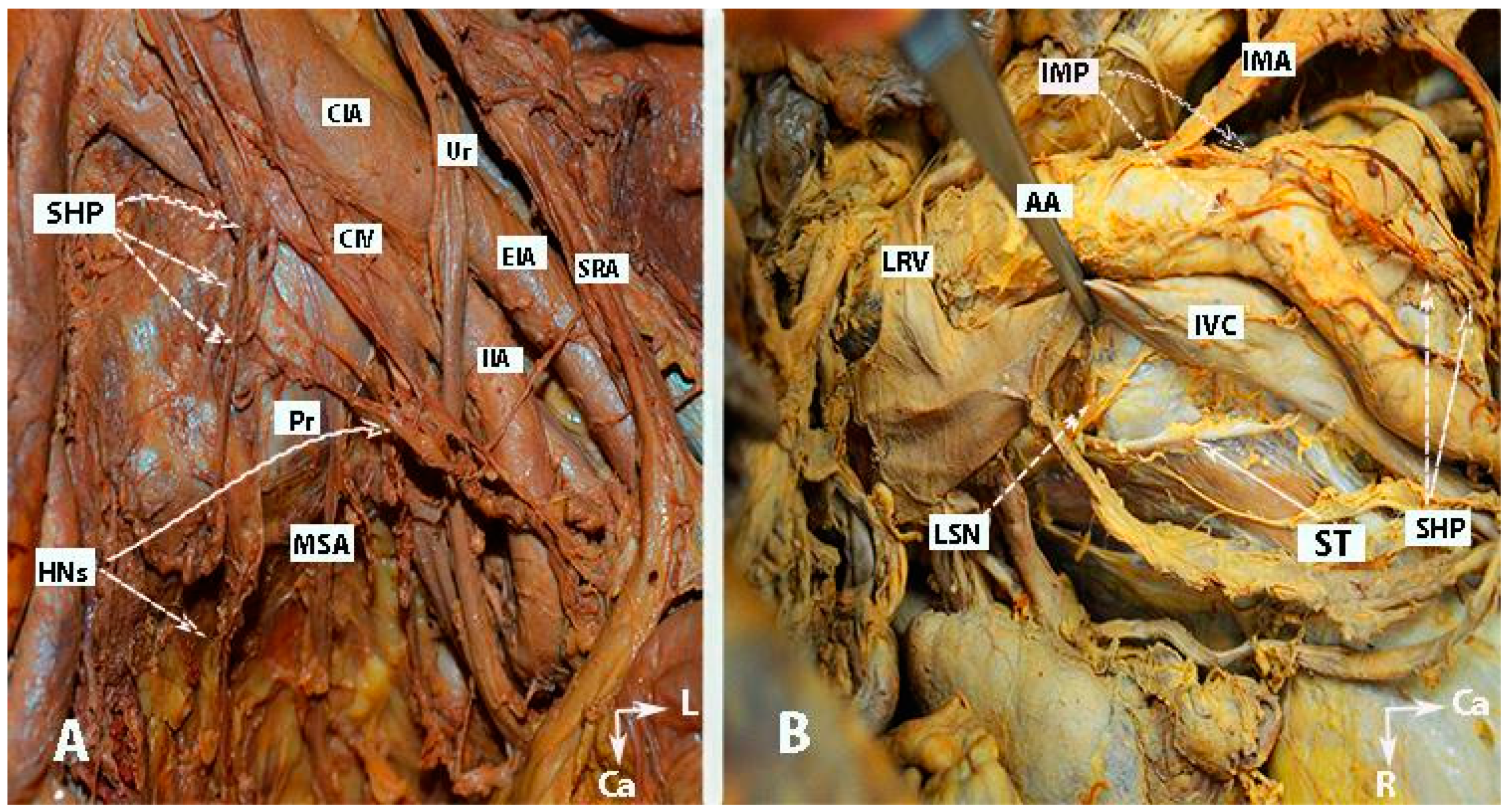
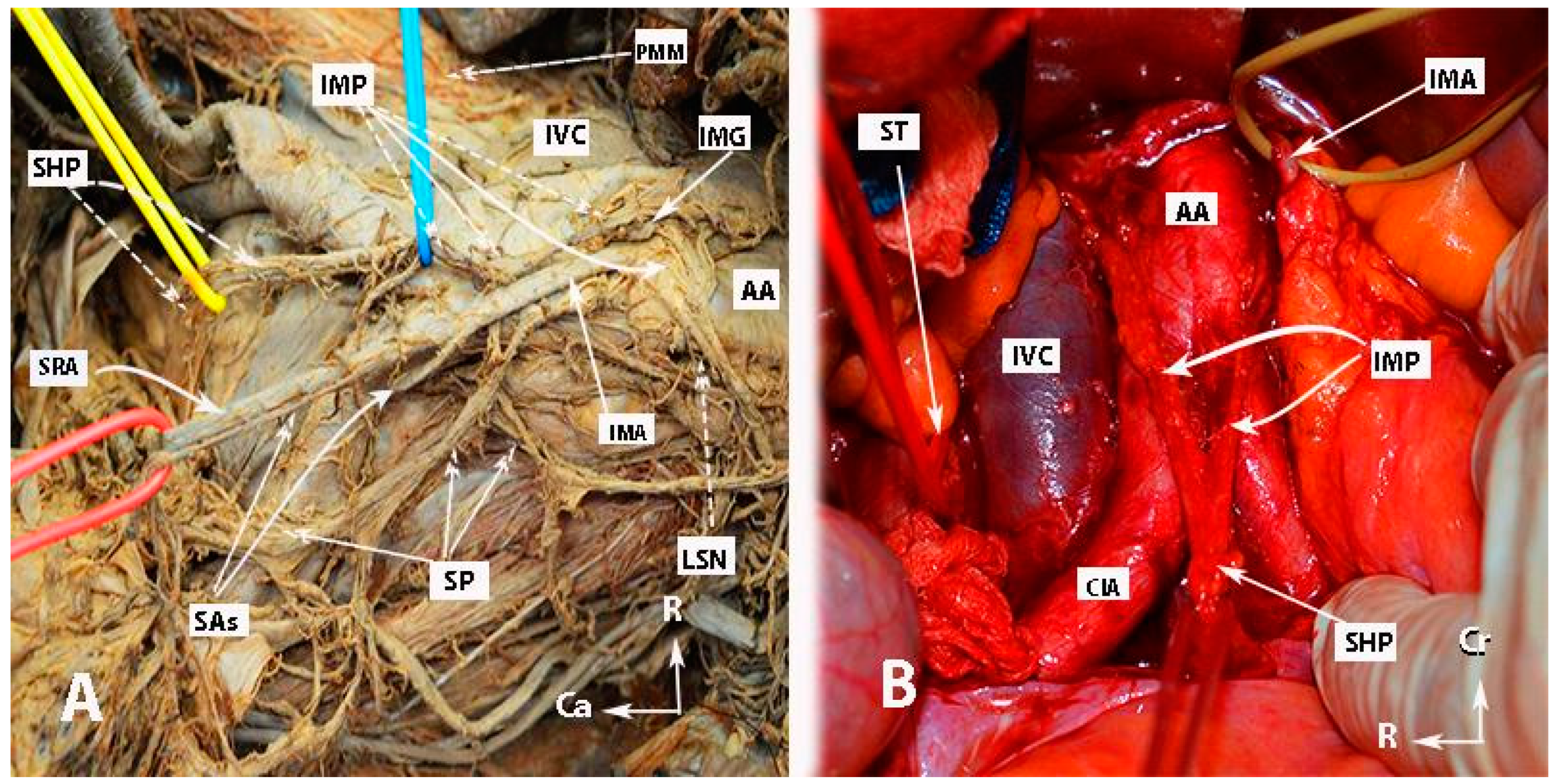
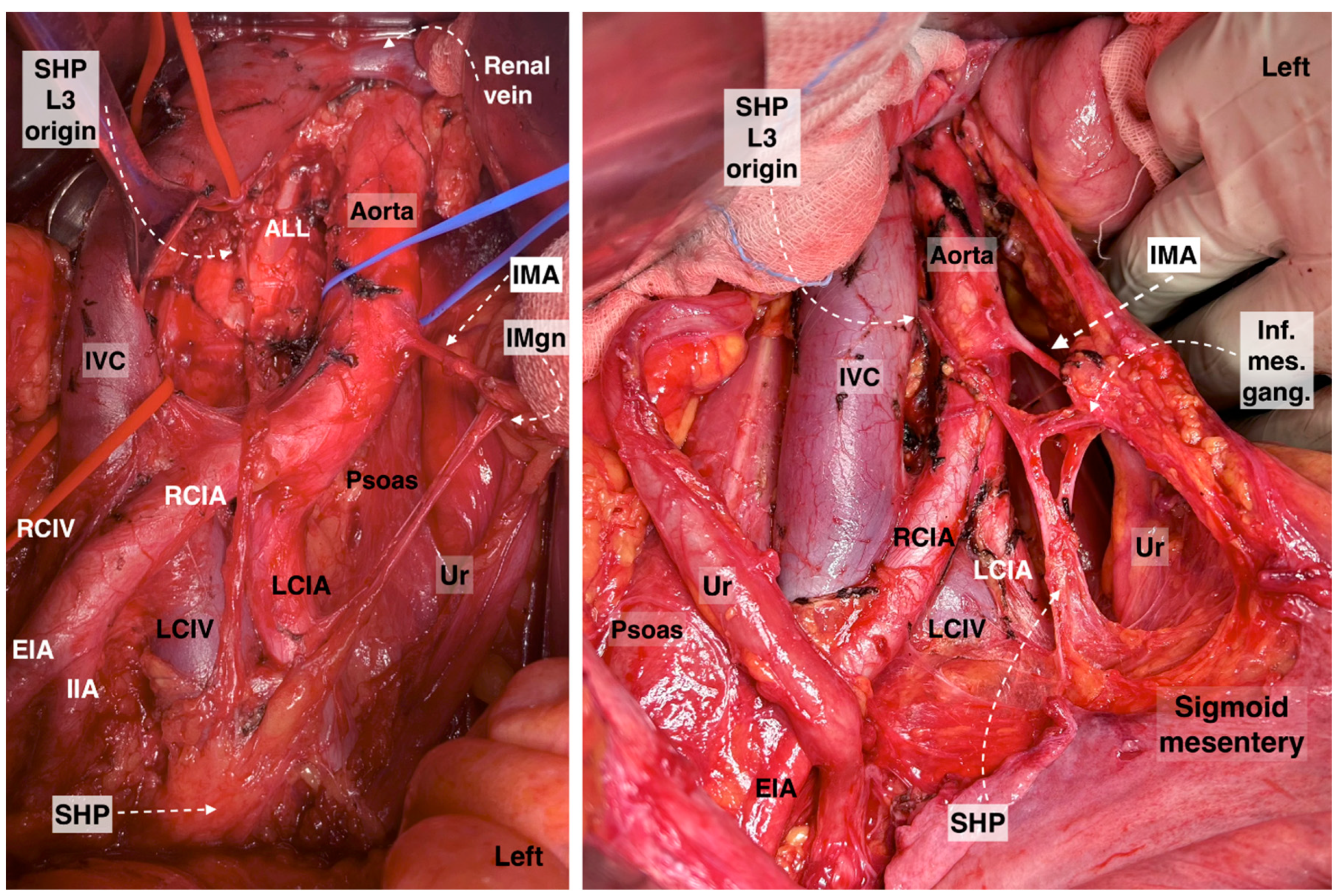
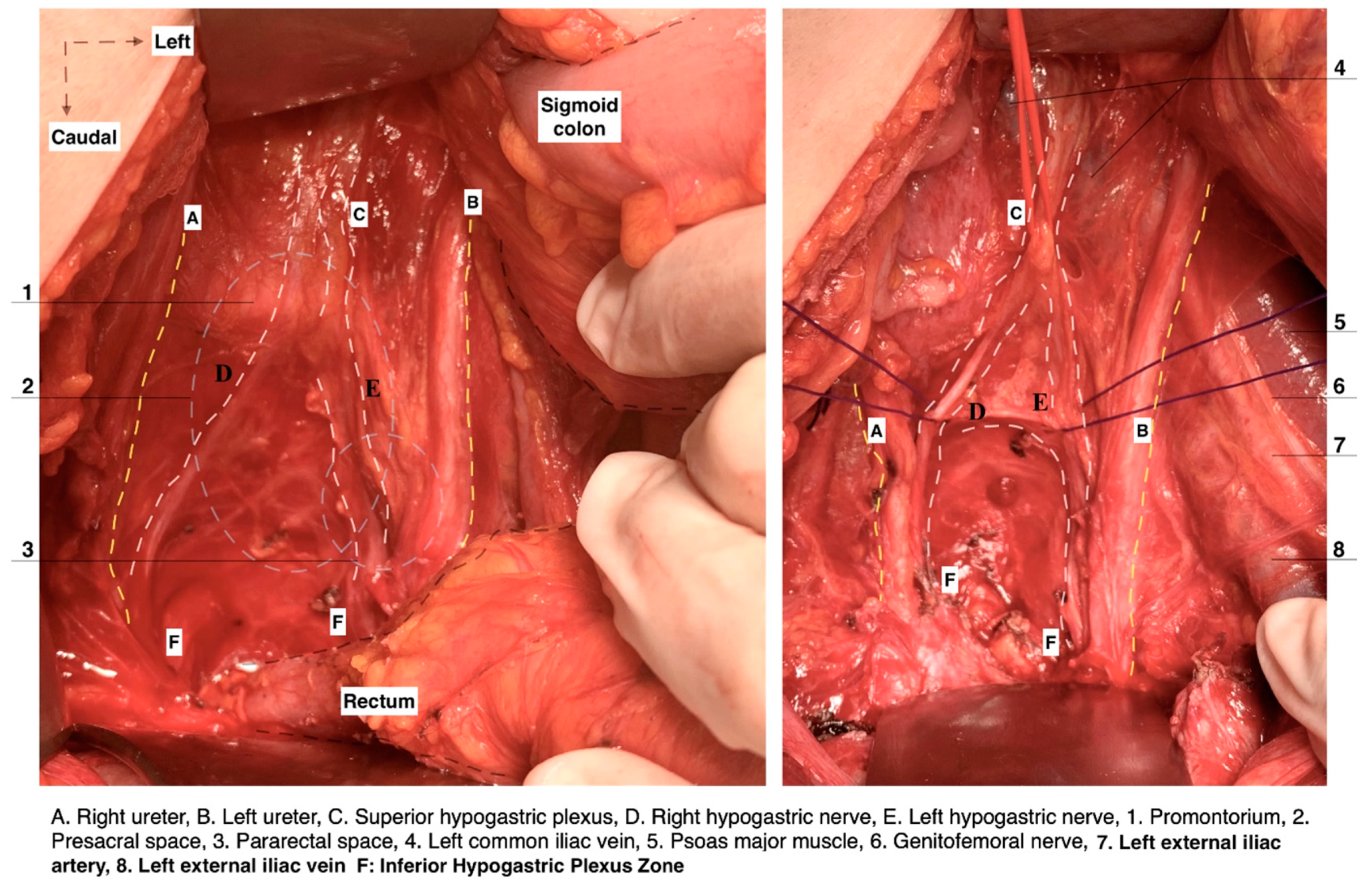
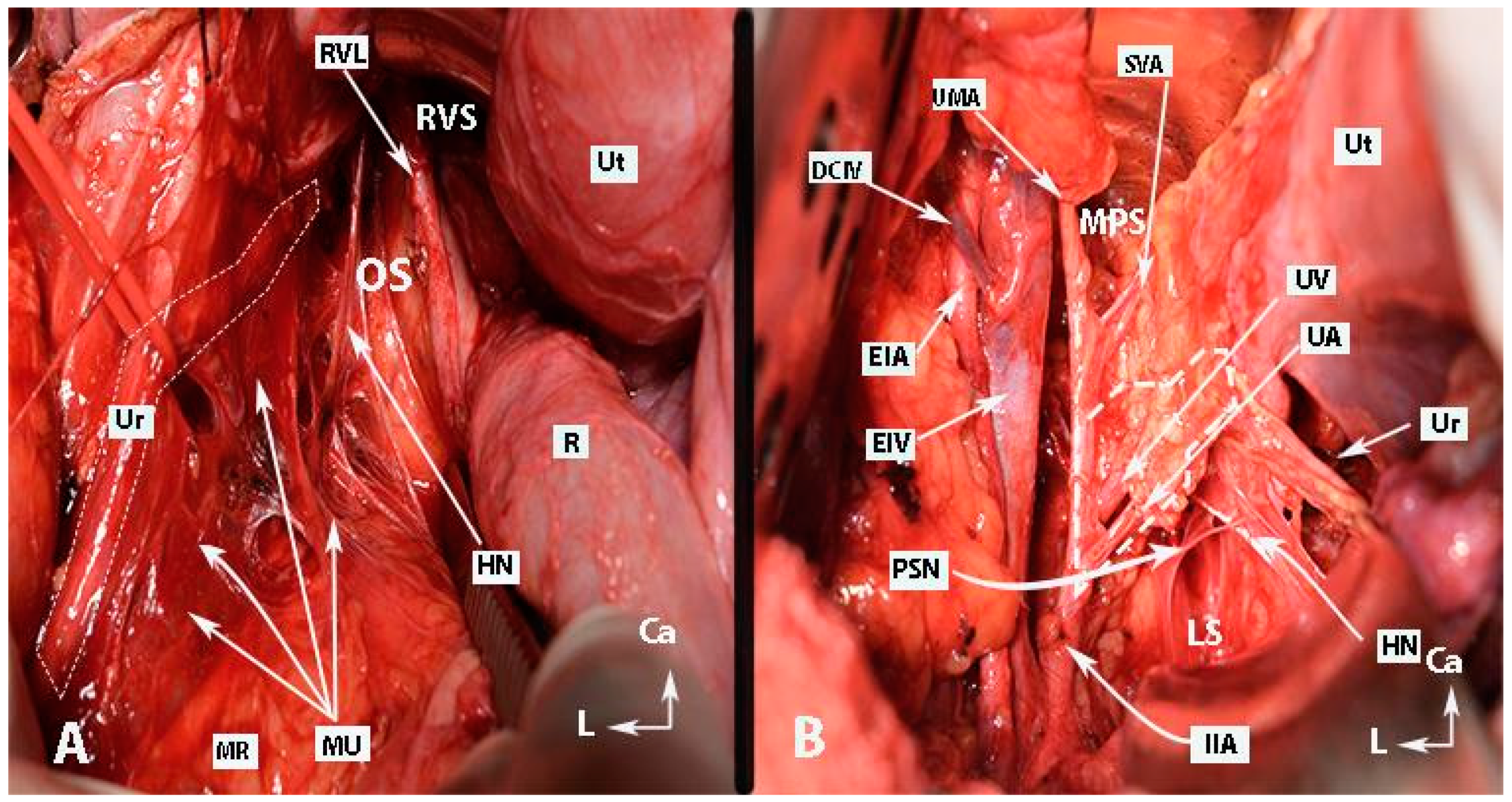


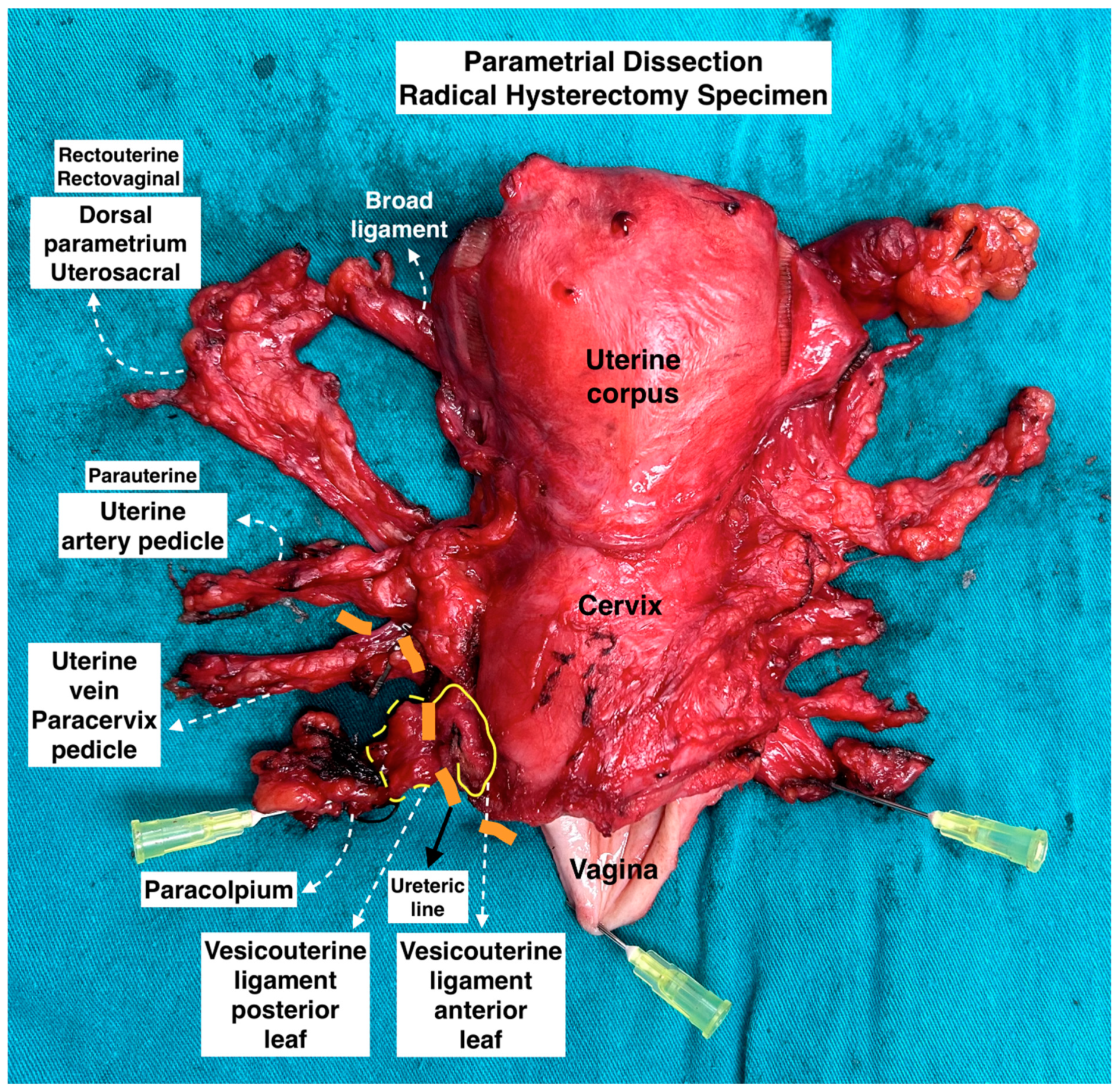
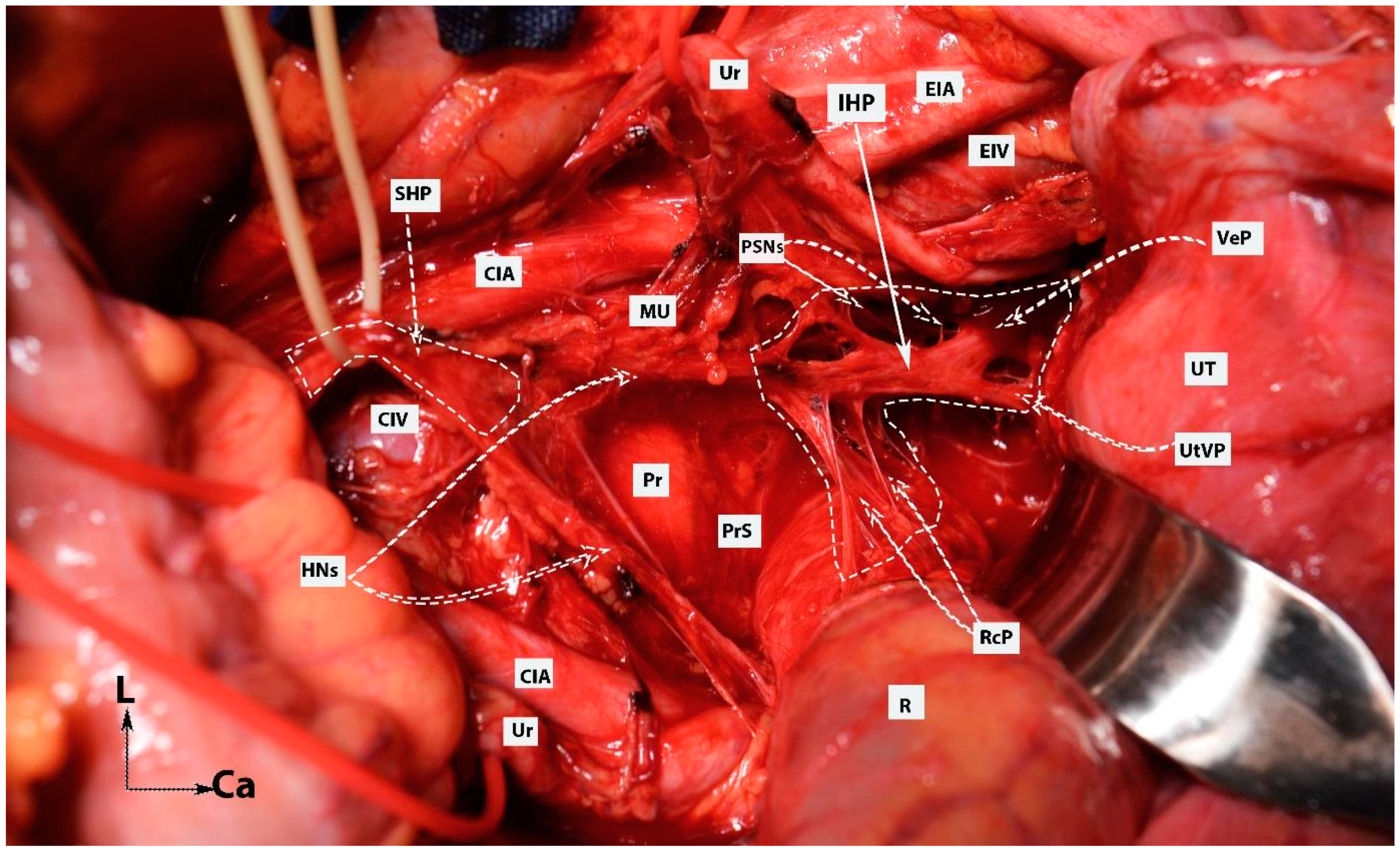
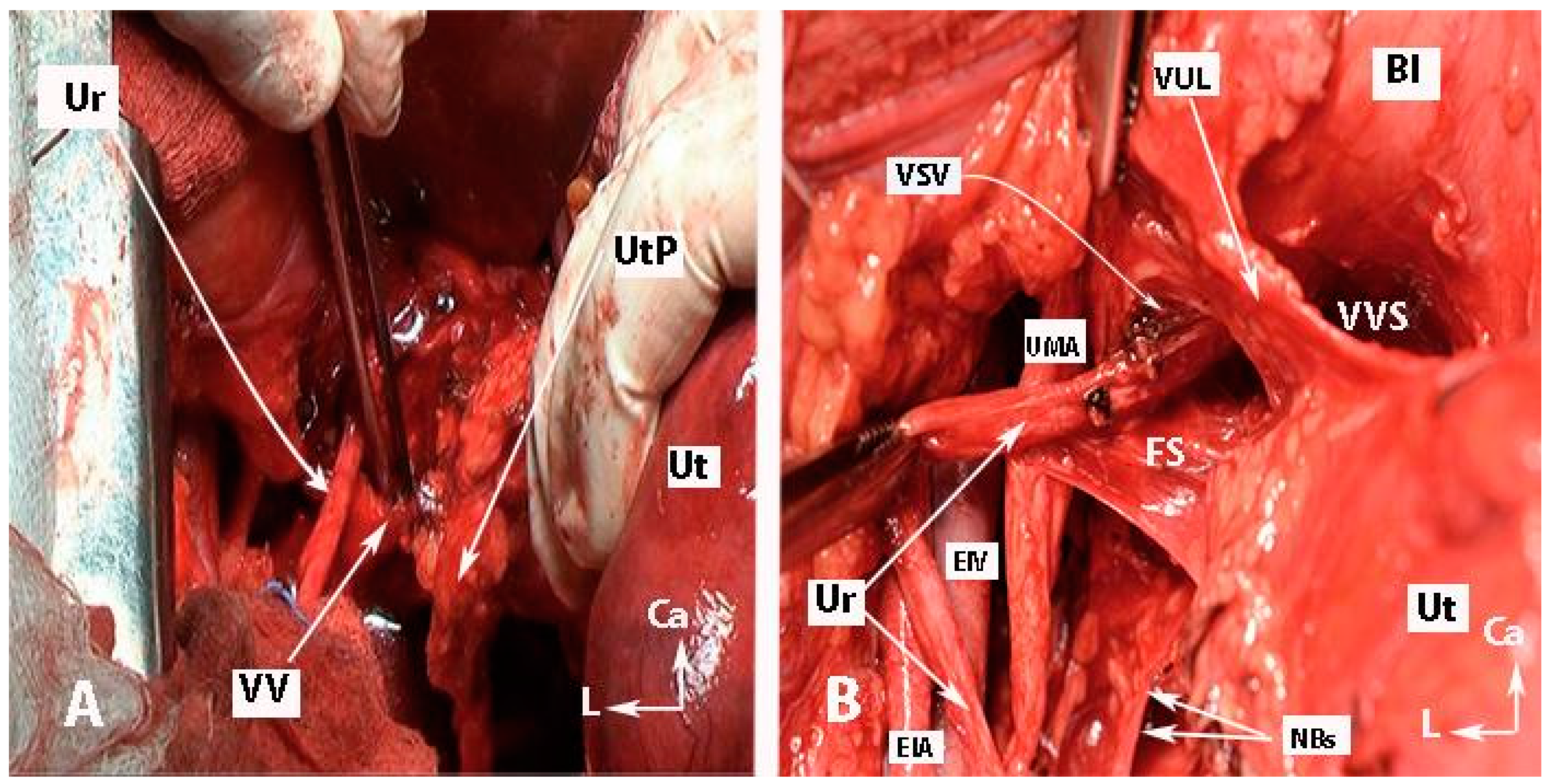
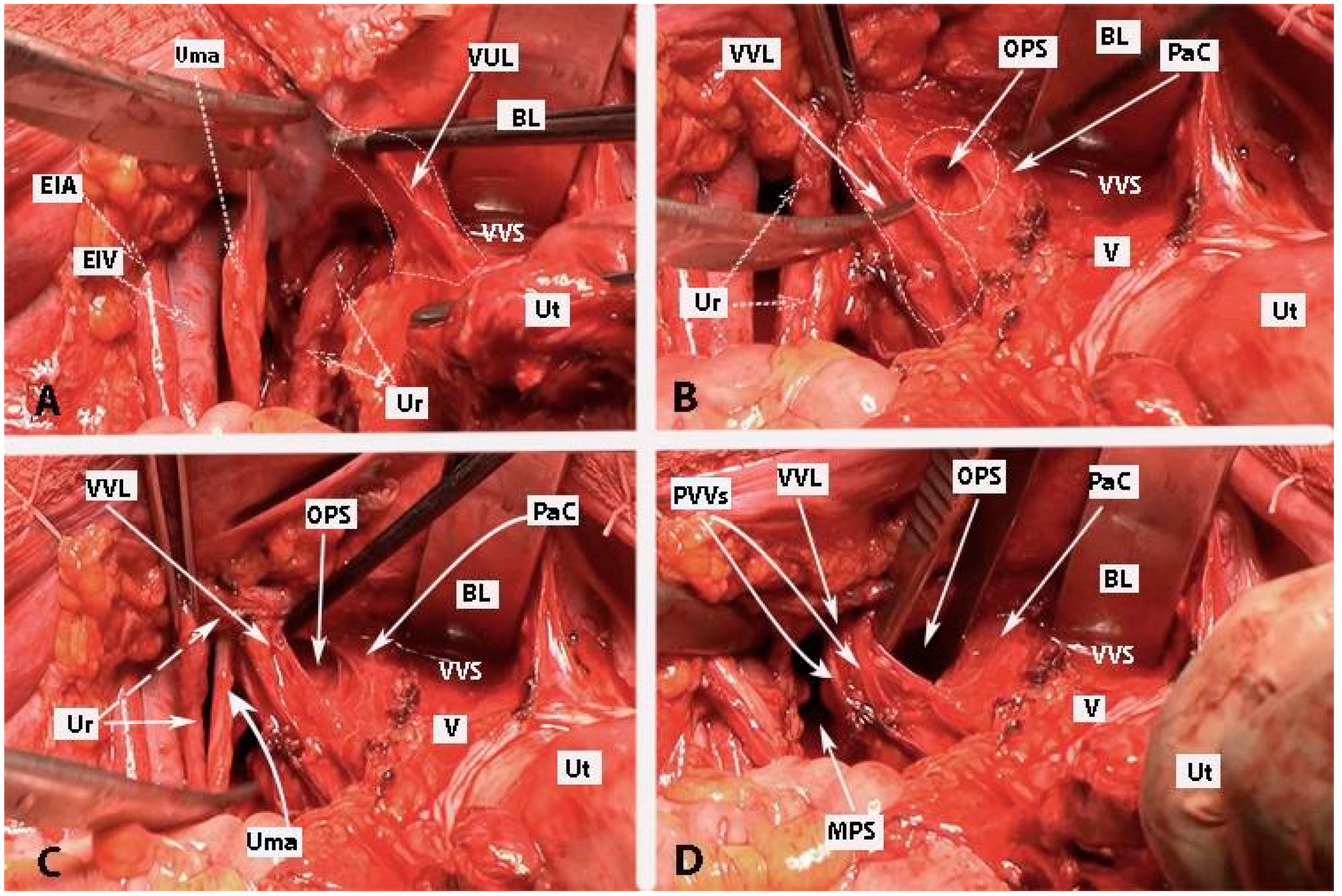
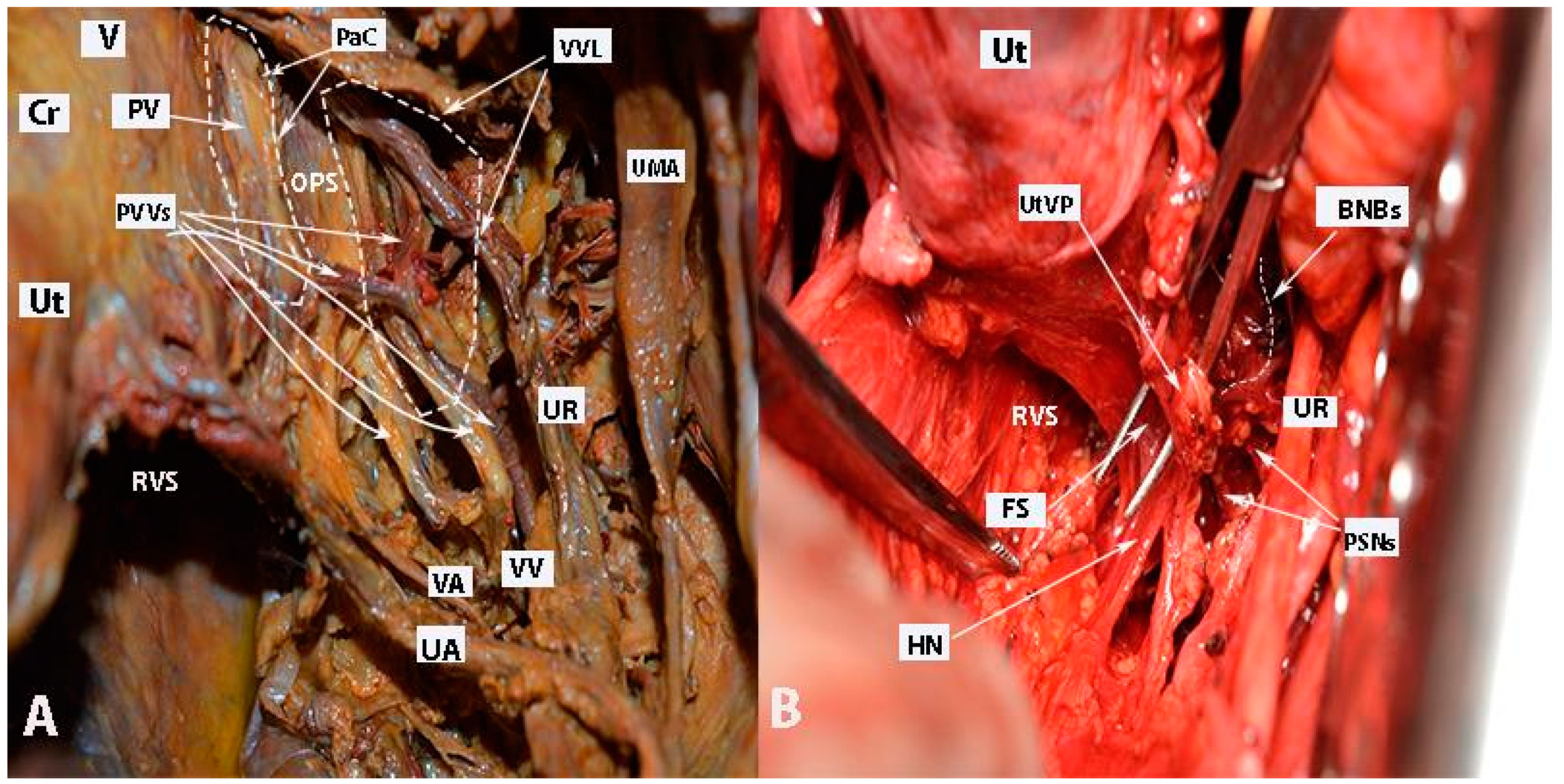
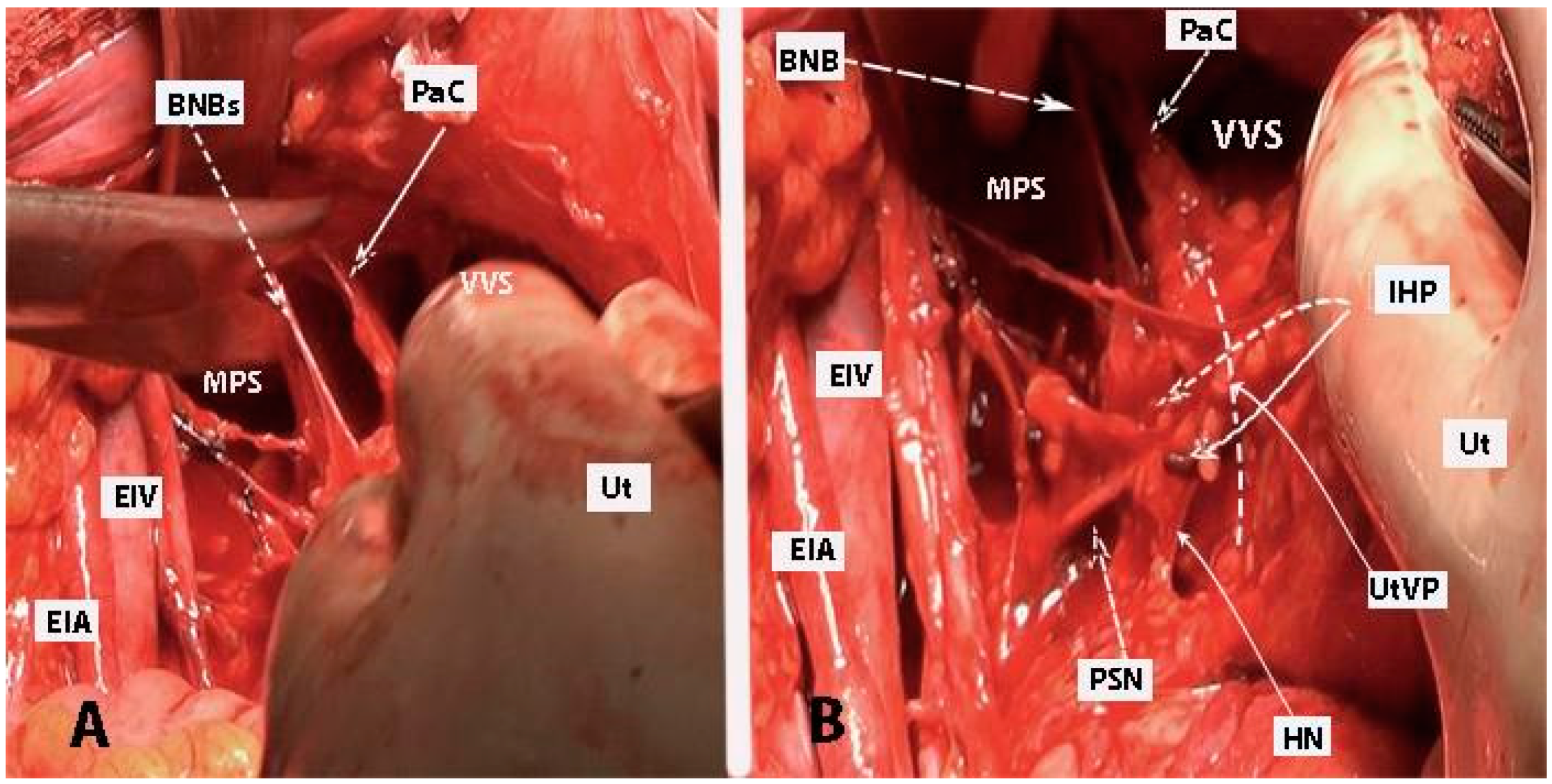
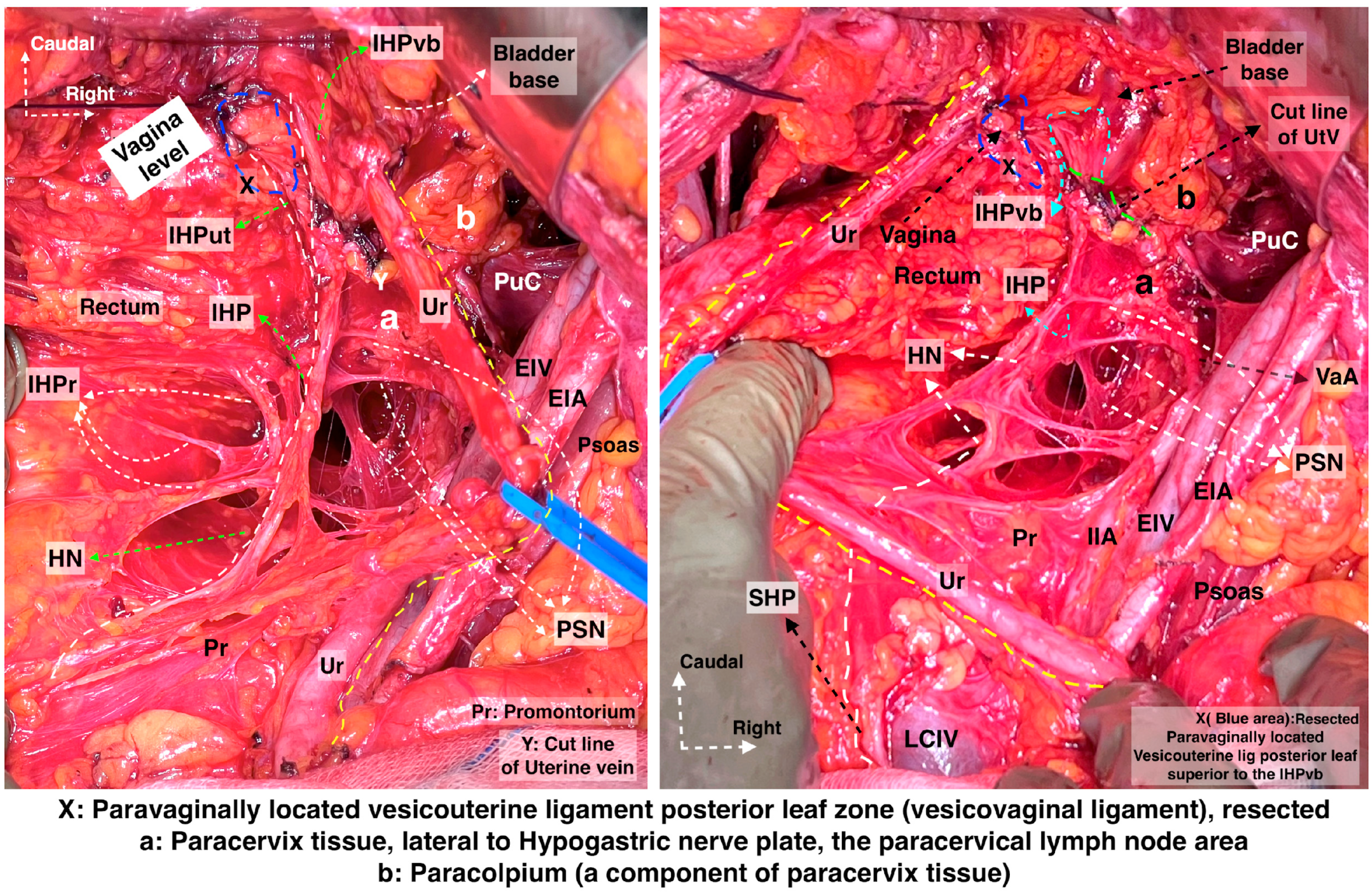
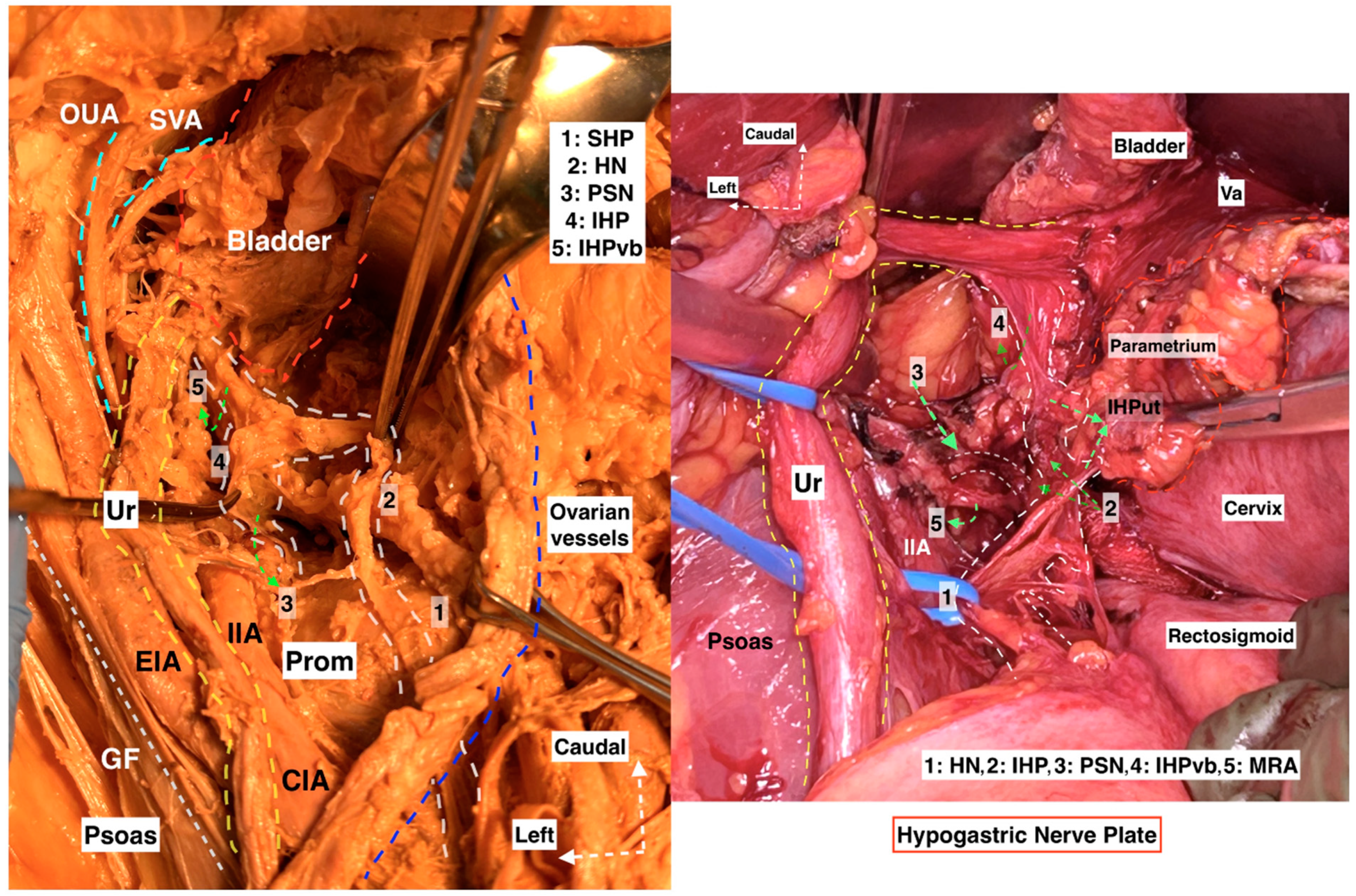
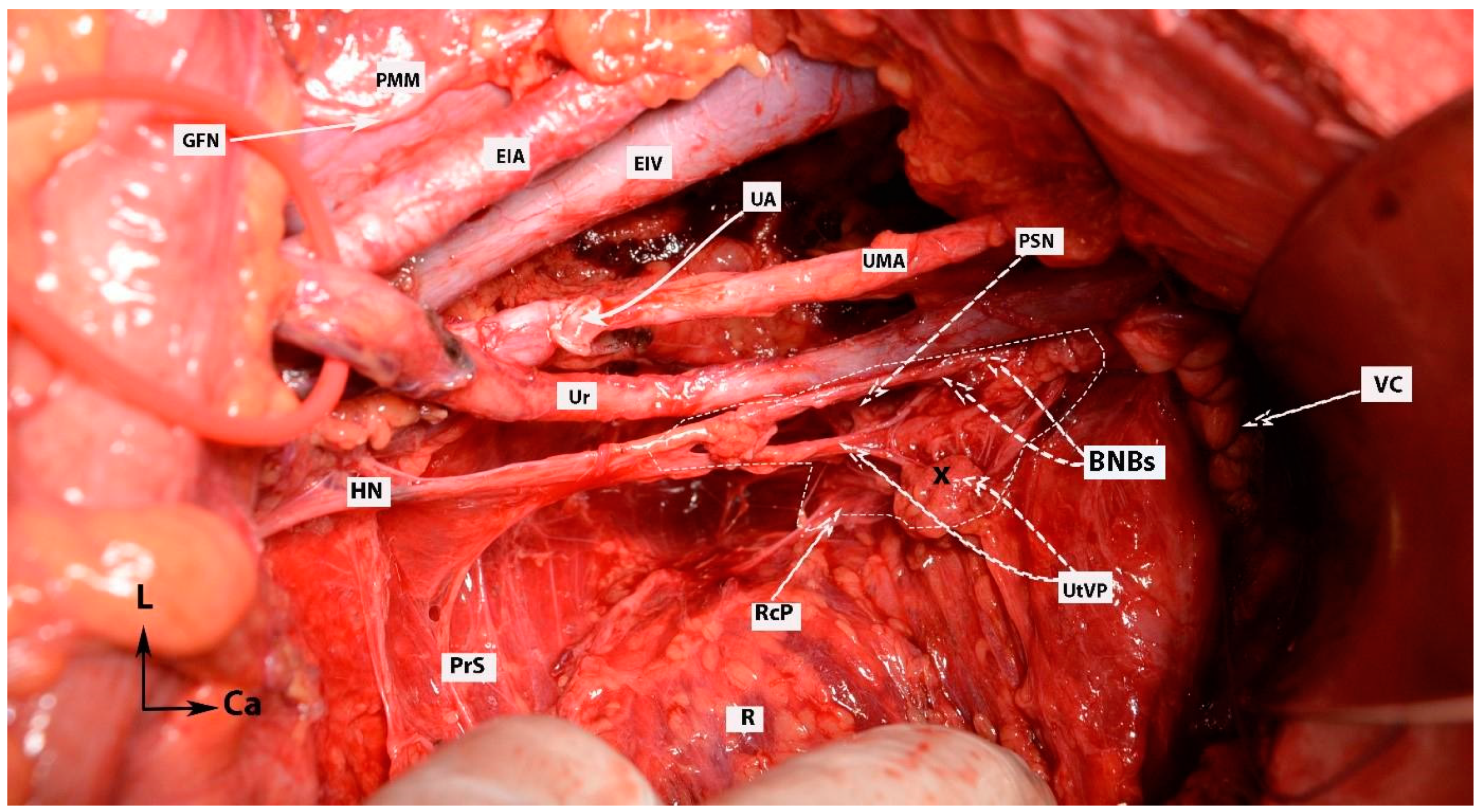
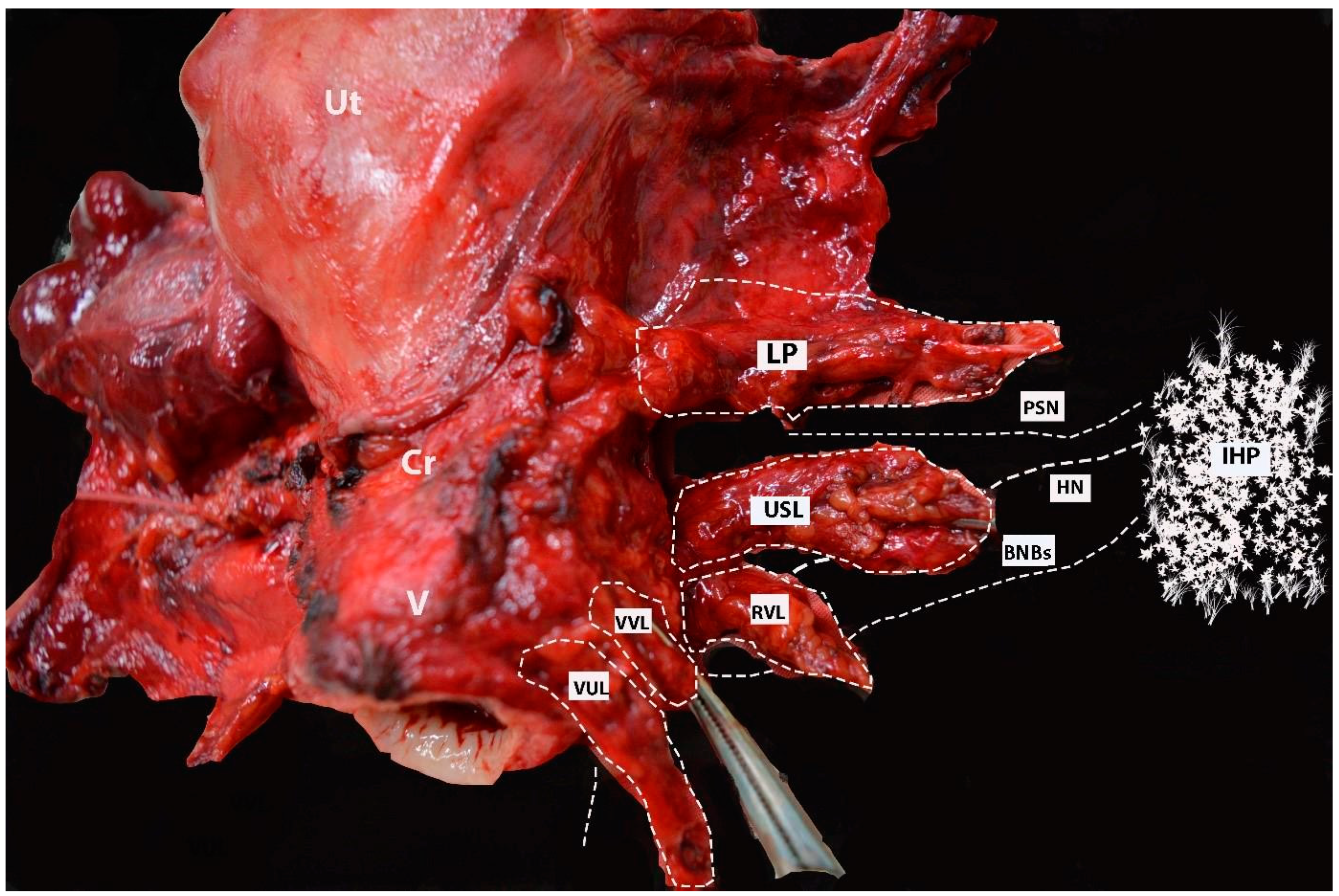
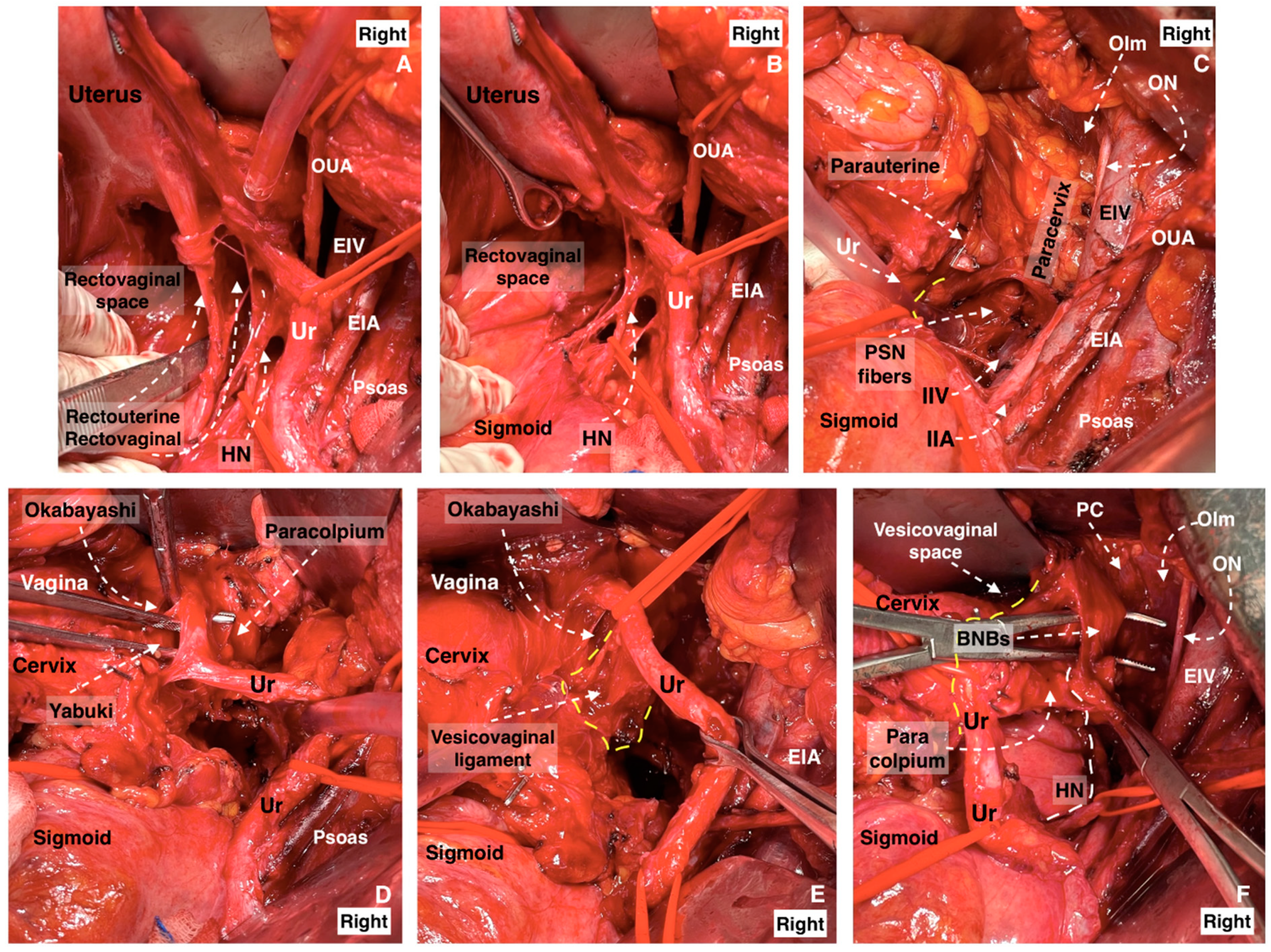
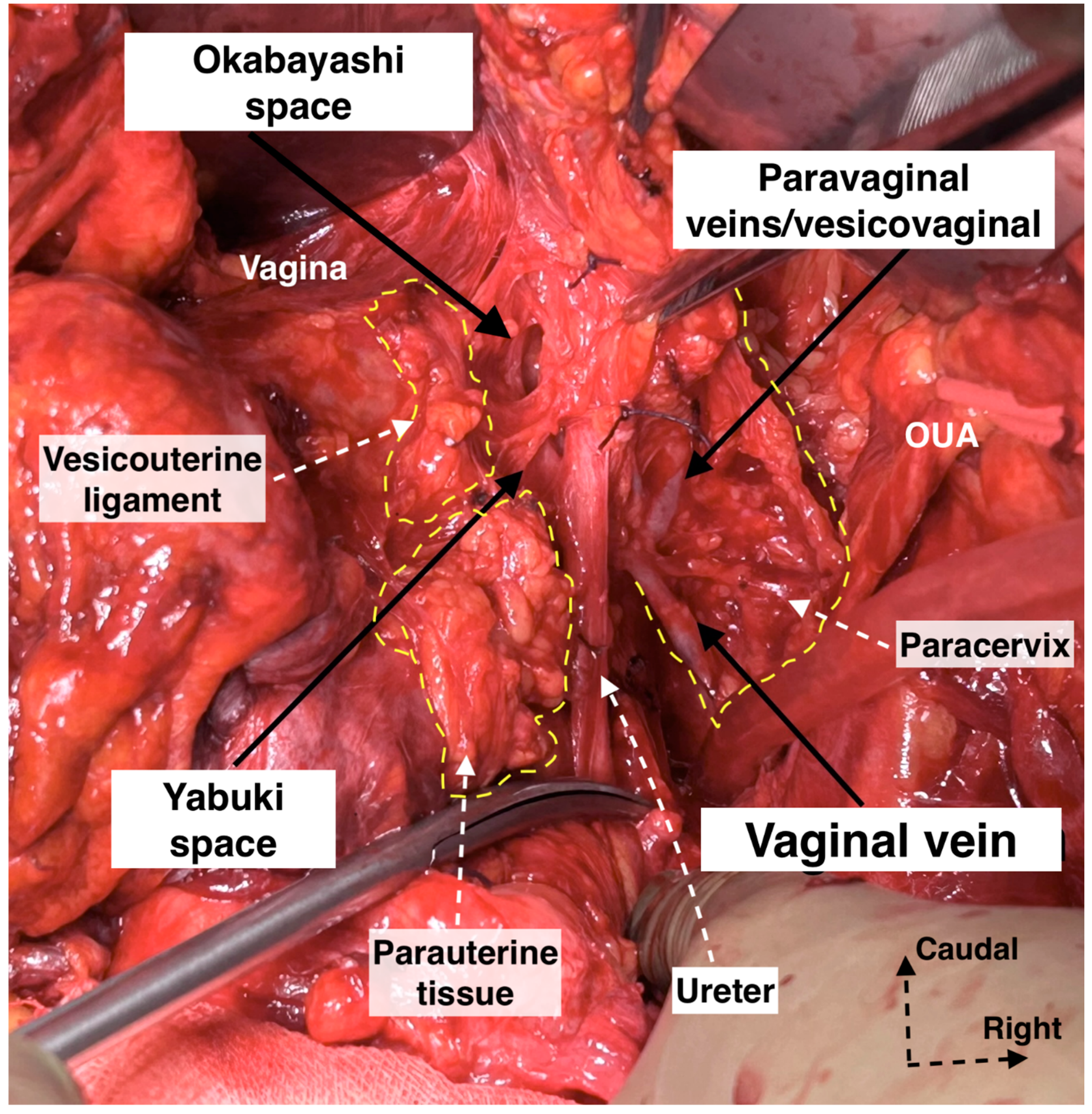
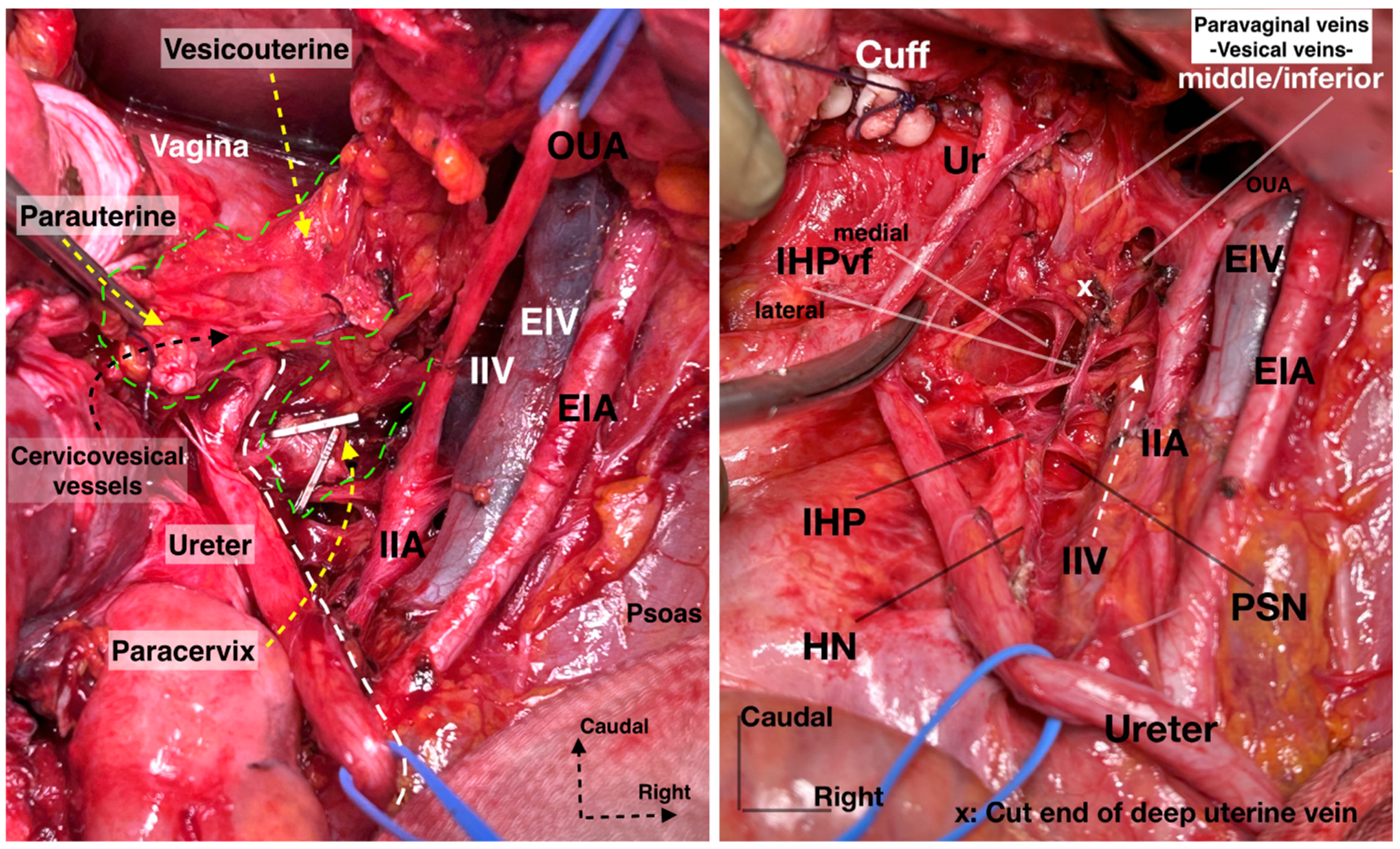
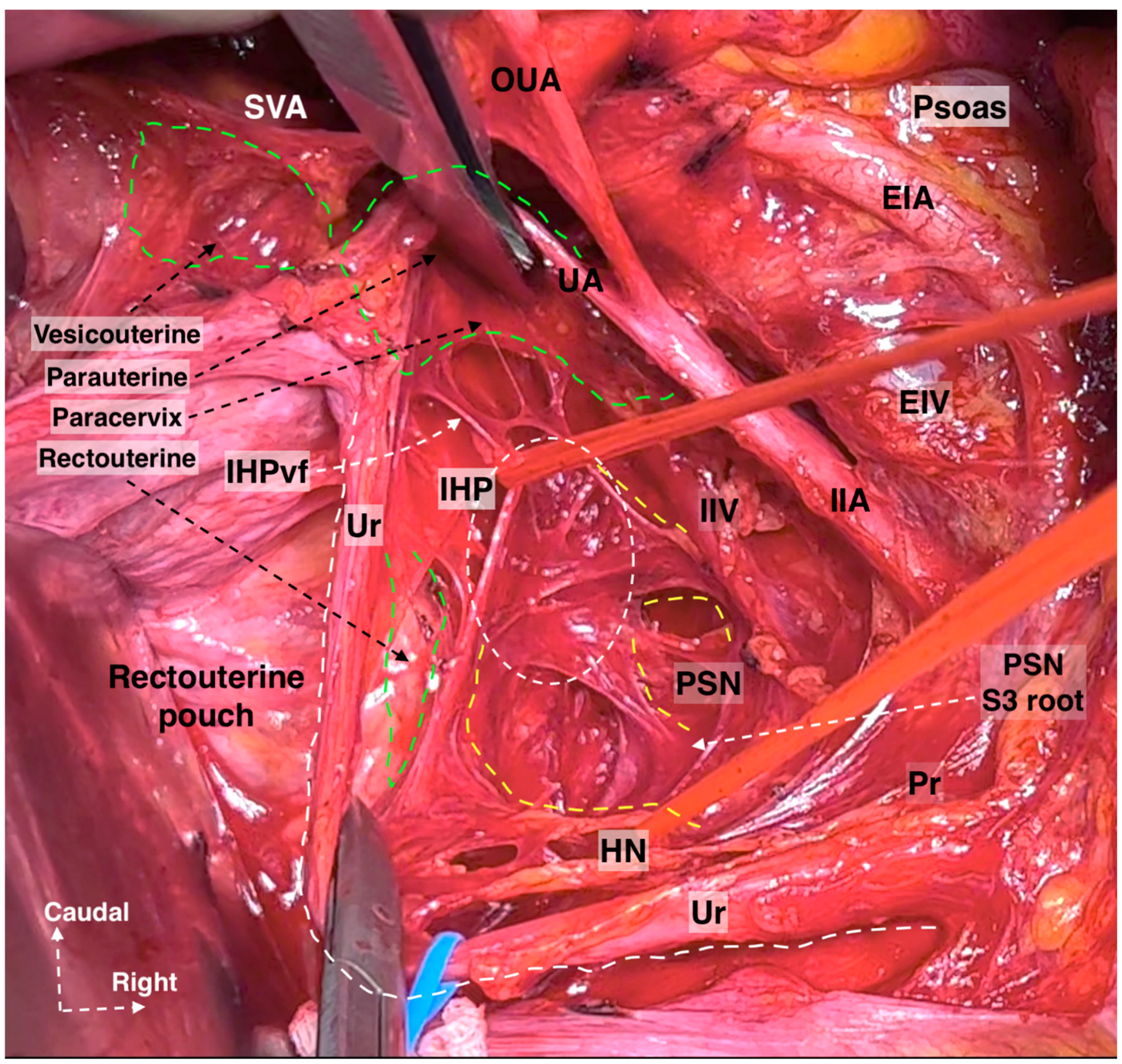
Disclaimer/Publisher’s Note: The statements, opinions and data contained in all publications are solely those of the individual author(s) and contributor(s) and not of MDPI and/or the editor(s). MDPI and/or the editor(s) disclaim responsibility for any injury to people or property resulting from any ideas, methods, instructions or products referred to in the content. |
© 2023 by the authors. Licensee MDPI, Basel, Switzerland. This article is an open access article distributed under the terms and conditions of the Creative Commons Attribution (CC BY) license (https://creativecommons.org/licenses/by/4.0/).
Share and Cite
Kostov, S.; Kornovski, Y.; Yordanov, A.; Watrowski, R.; Slavchev, S.; Ivanova, Y.; Ganev, T.; Yalçın, H.; Selçuk, I. Surgical Anatomy and Dissection of the Hypogastric Plexus in Nerve-Sparing Radical Hysterectomy. Diagnostics 2024, 14, 83. https://doi.org/10.3390/diagnostics14010083
Kostov S, Kornovski Y, Yordanov A, Watrowski R, Slavchev S, Ivanova Y, Ganev T, Yalçın H, Selçuk I. Surgical Anatomy and Dissection of the Hypogastric Plexus in Nerve-Sparing Radical Hysterectomy. Diagnostics. 2024; 14(1):83. https://doi.org/10.3390/diagnostics14010083
Chicago/Turabian StyleKostov, Stoyan, Yavor Kornovski, Angel Yordanov, Rafał Watrowski, Stanislav Slavchev, Yonka Ivanova, Tosho Ganev, Hakan Yalçın, and Ilker Selçuk. 2024. "Surgical Anatomy and Dissection of the Hypogastric Plexus in Nerve-Sparing Radical Hysterectomy" Diagnostics 14, no. 1: 83. https://doi.org/10.3390/diagnostics14010083
APA StyleKostov, S., Kornovski, Y., Yordanov, A., Watrowski, R., Slavchev, S., Ivanova, Y., Ganev, T., Yalçın, H., & Selçuk, I. (2024). Surgical Anatomy and Dissection of the Hypogastric Plexus in Nerve-Sparing Radical Hysterectomy. Diagnostics, 14(1), 83. https://doi.org/10.3390/diagnostics14010083








